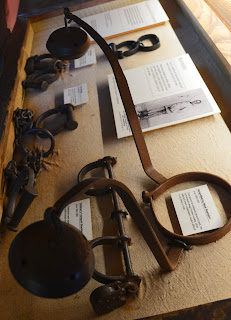As I researched, I found a lot of plantation tours. I wasn't sure how the grandkids would do with one of those. Would they get bored? Would they whine or cry during a tour? I decided to send out a general text asking what everyone thought about a plantation tour. Everyone, including parents seemed to think it was a good idea.
Next was finding one that wasn't ridiculously expensive. Once I found the power pass site, that became easier. There were two that we could see with that pass. After looking at websites, and asking for input, I decided to go to Oak Alley Plantation. Its site described a tour that, besides the manor house and grounds, there was also the history of the lives of the slaves that made the plantation what it was.
I was struck by the extremes in the difference in life between slave and owner. I mean, I knew, I knew that the difference was horrifying. The clash between the harsh reality of the slave, and the ridiculous, pampered extravagance of the plantation house was stomach turning. On display were shackles used on children. On children. I have never lived in a delusion believing that children were not treated horribly as slaves. Still, seeing an actual set of shackles, that were used on precious children, was heartbreaking. I looked at my grandchildren, and looked back at the shackles. I tried to imagine the feelings of parents and grandparents seeing their beloved children wearing these evil contraptions. There is no imagining such things. No way to ever know how these parents felt. I had to hug my granddaughter.
The houses for the slaves were very simple and very meager. The "house slaves" ranked a little better. Their clothes were in better repair and made of better fabric. Not because the plantation owner felt they deserved something a little better. No, it was because having slaves, that neighbors would see in the house, dressed in nicer clothes, was a status symbol. It meant that the plantation was doing well, and the owners were very rich. If they dressed their slaves nicely, they obviously were superior to everyone.
The house slaves were also provided with a few more sticks of furniture. Perhaps a small, simple table as well as a chair and bed. The field slaves had even less. The look of their clothes did not matter to the status of the owner. Their comfort was not a priority.
When not working in the field, some slaves were allowed to raise chickens, and gardens. The produce and eggs could be sold back to the plantation owner. This was about the only way a slave could earn a little money of their own. Most slaves were not allowed this opportunity. The ones that were, at least had a small sliver of hope to one day buy their freedom.
The life and work on the Oak Alley Plantation was filled with blistering and dangerous work. It was a sugar plantation, as was common in the area surrounding New Orleans. The work in the field was only part of the misery of the hard work of a sugar plantation. The sugar also had to be boiled, in large cauldrons in the heat of the summer. Heat exhaustion must have been rampant. You can imagine the fires that must have been needed to boil sugar in a cauldron that big. With fires like that, clothes were likely caught on fire causing life threatening burns. Today the cauldrons are filled with water lilies.
The cauldrons were also used for laundry. Trying to wash clothing in these must have been back breaking work on the best days. In the heat of the summer, truly grueling. Typically, different cauldrons were used for laundry than sugar boiling. The photo below, next to the house and fence gives you a better idea of how incredibly large these cauldrons were.
The thing that angered me the most was a sign that showed examples of how one race of people dehumanized and belittled another by putting a monetary value them. It had copies of ledgers of the price people were bought and sold for. People. As if they were cattle. People. Treated as lesser beings based solely on the amount of melamine in their skin. People. Who's histories and futures were stolen from them because someone saw them as property. People. Kidnapped and ripped from their African homelands and families. People.
People whose lives were important. People who loved, laughed and danced. People who's children were ripped away and sold off while they cried out. People who's identities were lost to history, but whose legacy runs deep in the south. A legacy that built the south. A legacy, without which the south would never have become what it did. The south owes much more than an apology to the people it enslaved. It owes a deep debt, one that cannot be repaid with mere money. It is a debt that should never be forgotten. We need to always remember the people that were affected by the greed and hate of the old south. A greed and hate that enabled slave owners to think of an entire group of people as "the other." The "other" was not as smart, not as clever, not as bright. The "other" didn't deserve basic human rights. The "other" was not human. The "other" needed to be controlled by their superior. Sound at all familiar?
The slaves of Oak Alley were not completely lost to history. Their names adorn one wall of one of the slave shacks. 200+ names. Their personal stories may be lost, but their spirit lives on in the trees and the land of Oak Alley. You can feel them there. Making sure their story is told. Making sure we never forget what one group of people can do to another.











Thank you,
ReplyDelete